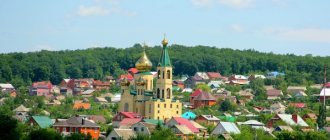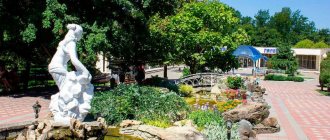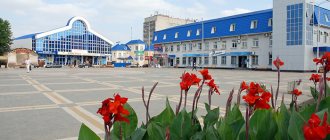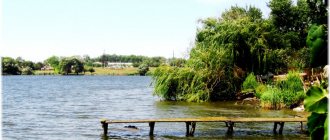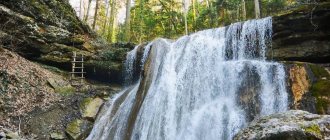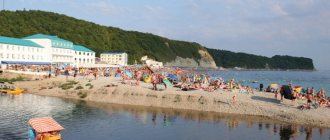Description of the resort city
The city is located on the banks of the Psekups River (a tributary of the Kuban), in a valley between the northern slopes of the Kotkh and Pshaf mountain ranges. It is literally buried in deciduous and mixed forests, greenery, flowers; and a large alley of tall coniferous trees (Alley of a Thousand Pines) leads to the health resorts at the ancient mineral springs. In the foothills there are dozens of large and small, old Soviet and more recently built sanatoriums and hotels, where tourists combine relaxation with health promotion. From these health resorts, excellent hiking routes are laid through the forested mountains - with bridges, ladders and fences in dangerous places.
Hiking along these hiking trails is very beneficial for anyone who suffers from asthma and other respiratory diseases. And any other person will also benefit from the local fresh air, enriched with beneficial phytoncides. The local climate can be described as exceptionally mild. It is transitional from humid subtropical to temperate continental.
At the Goryachiy Klyuch balneological resort, several types of mineral water are used. Thermal (up to +60 C°) sulfide chloride-bicarbonate sodium springs are used for medicinal baths. This treatment is prescribed to patients with diseases of the musculoskeletal system, peripheral nervous system, and female genital area. Mineral waters from sources No. 21, 58, 104 are taken orally. They belong to the hydrocarbonate-chloride-sodium type and are similar to the Essentuki waters, differing from them in the gas fraction. In Essentuki there is carbon dioxide, and in Goryachy Klyuch there is hydrogen sulfide. All these mineral waters are presented in the ancient Drinking Gallery, located on the territory of the sanatorium park. You can drink as much as you like for free, but you have to pay to take water out of the gallery (with the exception of a small 0.5 liter bottle).
Drinking gallery in Healing Park.
On the southwestern outskirts of the city, close to the mountains, sanatoriums, boarding houses and hotels are concentrated. The complex of buildings of the main sanatorium “Goryachiy Klyuch” is a real architectural monument. Most health resorts are adjacent to the Mountain (Healing) Park or are located directly inside it.
This magnificent park has no clear boundaries and in many places simply merges with the wild forest. On the territory of the Healing Park there are Mineralnaya with the Alexander Spring, from which history began, and the beginning of Dante’s Gorge, and the beautiful Iverskaya Chapel, right in the mountain, and the ruins of the ancient fortress Psyfabe, and the Cockerel rock. From the park you can go to the embankment of the Psekups River and walk along the suspension bridge over this river. The outskirts of the city are famous for the presence of numerous caves, waterfalls on mountain rivers, and mysterious ancient dolmens.
Sights of Goryachiy Klyuch
Goryachy Klyuch is a great place for those who want to improve their health, as well as for those who prefer natural attractions to architectural and museum attractions. Here you will not find merchant buildings, unusual museums or many churches and temples, but their absence is compensated by a great variety of rivers, waterfalls, mountains and, of course, mineral springs.
Healing Park
The park, which is considered the most healing and picturesque place in the city, was created in 1870. Throughout its long history, it has constantly developed and expanded. Today there is everything for a comfortable rest and healthy body: shady alleys, comfortable gazebos, benches and, most importantly, mineral springs.
The park is not marked in any way in terms of its exact boundaries - it seems to merge with the forest that extends right outside the Healing Park
More than a hundred plant species grow in the park, and each hiking trail can take tourists to one of the local attractions:
- Iveron Chapel;
- Dante's Gorge;
- Cockerel rock;
- Key mountain, etc.
At the very entrance to the park there is the Alley of a Thousand Pines, which consists of various types of this tree. Here you can find both ordinary pine and rare species, for example, Koch pine. The alley stretches for two kilometers, and all the trees here have the same shape and height and are located at the same distance from each other. The alley is the creation of schoolchildren who carefully planted trees here several years ago.
There are many birds in the Avenue of a Thousand Pines - and the calm silence is constantly interrupted by their beautiful singing, this is another feature that attracts tourists here
Address: Lenin street.
Iveron Chapel
The chapel was built on the slope of Klyuchevaya Mountain in the second half of the 19th century. For several centuries, a mineral spring flowed here, but in the 20th century, due to changes in mountain strata, the source dried up. All that remains from it is the chalice and the chapel itself, in which the image of the Iveron Mother of God is still kept, and services are held here every Friday.
The Iveron icon, according to the canons of the Orthodox faith, helps in deliverance and miraculous healing from diseases and ailments
Not far from the chapel building there is a monument to Living Water, which has no analogues in any country in the world. It was installed at the site of the concentration of mineral springs in 1914.
The Living Water Monument was erected to mark the fiftieth anniversary of the development of the resort
Address: Healing Park.
Abadzekh (Key) Mountain
The mountain is located on the banks of the Psekups River and rises above the water stream by less than 400 meters. The name "Abadzekh" mountain received from the name of the ethnic group - Abadzekhs, who once lived in this area.
Scientists suggest that Key Mountain appeared about 10-15 million years ago after the greatest tectonic uplift of one part of the river bank occurred here.
Dante's Gorge
The gorge is the result of the joint creation of man and nature. According to legend, it was cut down by local Cossacks, but the exact date of its formation does not exist. Nature made its contribution, because thanks to snow and rain, the gorge widened significantly, and the sharp rocks took on soft features and were covered with moss. Today the gorge is one hundred meters deep, the height in some places reaches fifteen meters, and the width - eight. The entrance to the cave consists of 49 steps carved from stone.
Local residents have a legend: supposedly every morning, at the very early hour, when the Dante Gorge and the surrounding area are completely deserted and quiet, a young girl appears next to the Key Stream flowing along the stairs - this is the mistress of the Dante Gorge
The name "Dante's" gorge received thanks to the creator of the "Divine Comedy" - Dante Alighieri, who described the entrance to hell as a "damp and cool place." This characteristic perfectly describes the climate in the gorge itself.
The gorge perfectly resembles the structure of the World: the bottom of the gorge is a dark and eternally damp Hell, everything is like in the “Divine Comedy”, and after getting out of the dark gorge, a person seems to find himself in Heaven - it’s so bright, light and beautiful here
Ladder of life
The staircase is located on the slope of Klyuchevaya Mountain, a hundred meters from another staircase leading to Dante’s Gorge. There is a legend that once on the top of the mountain the Adyghe people carried out executions - criminals were thrown off the cliff. However, they were given a chance for salvation - they could escape from death using the stairs, and this is how the modern name Staircase of Life appeared.
Thanks to the Ladder of Life, the death penalty was almost never carried out
Rock Cockerel
The rock was formed more than fifteen million years ago thanks to the waters of the Psekups River, which ground and created the outline of the rock for many millennia. The height of the mountain is not very high - a little less than thirty meters. It got its name thanks to local holidaymakers who once decided that its image was similar to the comb of a rooster. However, several centuries ago it had a different name - the Rock of Salvation; it was from it, paradoxically, that the Adyghe tribes threw off criminals.
In 1864, just in time for the arrival of the Great Russian Prince Mikhail Nikolaevich, a gazebo was built on the top of the rock, which to this day is called the royal one.
Psyfabe Fortress
On the Cockerel rock is located one of the oldest defensive fortresses in the country - Psyfabe, presumably built in the 5th-7th centuries. The name is rooted in the Adyghe language and means “warm water”. The construction was intended to protect local residents from enemy raids. According to a study conducted by archaeologists, it is believed that the total area of the defensive structure was about two hundred square meters. Only small parts of the fortress have survived to this day, but even from them one can judge how strong and impressive its walls were - their width reaches three and a half meters.
The medieval fortress used to be one of the main defensive structures in Russia
Alexandrovsky spring
Alexandrovsky spring is one of the oldest springs in the resort city. It was thanks to him that a hospital was once formed here. But he gained fame much earlier than the appearance of the health resort. It is believed that the ancient Greeks used the healing power of local water, evidence of this is the ancient precious coins they brought as a sign of gratitude, and which can be seen here today.
Every year, tourists and vacationers go to Goryachy Klyuch who want to experience the miraculous properties of the mineral water of the Alexander Spring.
Hell's Falls
Hell's Falls is the most mysterious and enigmatic place in Goryachy Klyuch. The water flow here is very strong and noisy, and it is framed by sharp stone ledges. Falling from a twelve-meter height, the water hits the rocks and falls into a deep pool. The waterfall received its name due to the gloomy sensations that beheld what they saw.
Hell's Falls is located in the Chepsi River basin, part of a tributary of Hell's Creek
Ayuk waterfall
Ayuk waterfall flows in a wooded, picturesque area. Its total length, which consists of two large steps, is about nine meters. The water flow foams strongly, which is why it acquires a snow-white hue. Its streams flow into a miraculous bowl, which is perfect for bathing.
Jets of water falling from a nine-meter slope have an unusual white color, this can be explained simply: numerous air bubbles form in the waterfall, and it is they that give this color
Kaverzinsky waterfalls
The waterfalls represent about a dozen water streams, but half of them do not have the required height, so they are not spectacular enough. The largest water cascade is twelve meters high. It falls from a fairly flat stone “wall”, which has symmetrical projections, as if created by human hands. The stream flows into a bowl formed by the water itself. Nowadays tourists often swim here. The water of the waterfall has a milky hue.
Kaverzinsky waterfalls are one of the most visited attractions of Goryachiy Klyuch. These places are famous for their beauty: unusual trees, ferns and mosses, Caucasian fir and yew grow here
Phanagorian Cave
No one knows the exact time of formation of the cave, but it is known that it already existed in the 17th century. Then a Turkish researcher visited and described it; according to him, the cave was large in size, and in its largest hall there was a statue larger than a human one. Unfortunately, no one else was able to find the statue. However, even without it, the cave can be considered perhaps the largest and most mysterious in all of Europe. Previously, pilgrims from all over Russia often prayed here, and Caucasians identified the Phanagorian cave with Tibetan Shambhala.
Local old-timers say that many years ago a cave tunnel led directly to the Black Sea
The cave is located at an altitude of three hundred meters above sea level. The entrance to it has a round shape and a diameter of one and a half meters. To get to the central hall of the cave, you need to overcome a ten-meter tunnel. The length of the entire cave exceeds one and a half thousand meters. According to scientists, some time ago the tunnels were about 25 kilometers long, but later some passages were blocked. The passages in the cave are not very wide; a shallow stream flows along its entire length, but the main hall is quite large - its vault is at a height exceeding human height.
Visiting the cave has a positive effect on health. The local air is weakly ionized, which helps to cure respiratory tract ailments, such as asthma. The temperature here is stable - +9 degrees; while walking through the tunnels, you can meet different types of insects and bats.
Bald Mountain
Bald Mountain rises on the banks of the Psekups River and its tributary Kaverze. The highest point is 423 meters above sea level. Although the mountain has a characteristic name, it does not reflect reality - there is a dense forest on it, in which you can find rare Pitsunda pines.
Some trees that grow on the slopes of Bald Mountain are quite old - they are already more than a hundred years old
On the mountain there is a monument dedicated to the soldiers who died during the Great Patriotic War, who defended Goryachy Klyuch from enemy attacks.
Podnavisla fortification
The settlement received its name due to the nearby mountain called Navisla. In the 19th century, a farmstead was formed under its slope, which was named Podnavisla . During the Great Patriotic War, the settlement played an important role for Soviet soldiers. Here the soldiers organized shelter and defensive structures that saved many people from death. The wounded were also treated here, and the dead were buried right on the territory of Podnavisla. At the end of hostilities, the farm was abandoned, and Arshaluys Khanzhiyan, a girl who nursed wounded soldiers and promised never to abandon them, remained to look after it. So she kept her promise, living alone on the farm for more than fifty years. She died at the end of the twentieth century and was buried here.
In 2000, a memorial was erected on the territory of the settlement in honor of the fallen soldiers, and two years later the Arshaluys monument was erected. In addition, two small churches were built nearby - an Armenian and a Russian one, and in the house in which the heroic woman lived out her life, a museum was opened telling about her life. Now the settlement has become a kind of Mecca for people who come here to honor the memory of the dead.
Photo gallery: Podnavisla Castle
The highest point of Mount Navisla rises at a distance of 704 meters above sea level
During the Great Patriotic War, Goryachy Klyuch was relatively calm for only one year, and already in August 1942 military operations came here
Arshaluys died in 1988
The Russian chapel was built in memory of Soviet soldiers who died on this land
The stone Armenian chapel was erected in memory of the Armenian girl Arshaluys
Drinking gallery of three sources
In the gallery you can taste the water that came here from three different sources. Each liquid has its own special taste, chemical composition and temperature. Anyone can get 0.5 liters of mineral water for free.
In the very center of the city, right in the sanatorium complex, there is a Drinking Gallery, into which water from three mineral springs flows through a special pipeline: No. 21, 58 and 104
Address: Psekupskaya street, building 2. Opening hours: 7.00–19.00, break - from 14.00 to 15.00.
Museum of History and Local Lore
The museum began its work in 1864, becoming the first such institution in the entire Caucasus. The excursions are designed for visitors of all ages. The local exhibitions tell about the ethnography of the region, its flora and fauna. The museum also presents archaeological and geological finds that highlight the history of local lands.
The Museum of History and Local Lore is located in a small building, and the number of its exhibits does not exceed 6,000 items
Four halls are open to visitors, designated for a certain period of time:
- the first - antiquity and the Middle Ages;
- the second - the period of formation of the Hot Spring;
- the third - the years of the Great Patriotic War;
- the fourth - the modern history of the city.
Near the museum building there is a monument to Alexander Sergeevich Pushkin, who loved the Caucasus very much and lived here for several years of his life.
Address: Lenin Street, building 132. Opening hours: 9.00–17.00, closed on Monday. Ticket price: from 50 rubles.
Bridge of Hope
The first bridge across the Psekups River was installed at this place a century ago. It was narrow and shaky, and during the Second World War it was partially destroyed. They did not dare to restore it, considering that it would be better to build a new bridge; the remains of the old one remained in place. The modern building is 70 meters long, suspended on steel cables and is one of the largest structures in the entire Caucasus.
The Bridge of Hope got its name thanks to a resort woman who realized that Goryachiy Klyuch is the very place needed by a person looking for relaxation and healing.
Arch with lions
The construction of the arch was completed in 1914, as evidenced by the inscription on one of its columns. On the second, the date of foundation of the resort is carved. The height of the structure is about five meters, and it was installed at the entrance to the Healing Park. Later, the park expanded its territory, so the arch moved inside.
Lions in the Caucasus are not a fiction; many years ago, even in ancient times, these powerful animals lived here; they were forced to leave these places by the people themselves, who mercilessly exterminated lions, hunting them for their valuable skin and large amounts of meat
After the end of the Second World War, sculptures of lions tormenting boars were installed near the arch. This picture symbolizes a person’s struggle with his illnesses and victory over them.
About the history and coat of arms of the city
Before the Caucasian War of the mid-19th century, the Circassian (Adyghe) village of Psyfab (“hot water” in translation) was located on the territory of the city. In the 1860s, in connection with the end of hostilities in the Caucasus, that part of the indigenous population that refused to recognize the power of the Russian Tsar was deported to Turkey. Including residents of the village of Psyfab. In 1864, a balneological resort was founded at local mineral springs by the military department. It included a military hospital, baths and drinking water pump room, and a park.
The village of Goryachiy Klyuch was founded in 1868, but in the 19th century, few people in the Russian Empire knew about this resort. From 1906 to 1920 the settlement was called Alekseevsky Goryachy Klyuch; in 1926 the place was transformed into a village; since 1930 it received the status of a resort village. During the Great Patriotic War, Goryachy Klyuch was occupied by fascist troops for several months. The growing resort village was recognized as a city on November 11, 1965.
Coat of arms of the city of Goryachy Klyuch.
The city's coat of arms symbolizes the favorable natural and climatic conditions of the resort and its mineral springs. On a blue background there is an arch and a tilted amphora pouring out water - all of this is silver. The arch symbolizes the open gate, a symbol of the hospitality of the residents of the resort city. The amphora and the water pouring out of it are a symbol of the source of life and health. In Soviet times, the coat of arms of Goryachiy Klyuch depicted gushing springs, a medical emblem (a bowl and a snake), and a ring with an ear of grain and a gear.
City Historical Museum
In the city of Goryachy Klyuch, the historical museum was founded in 1864. This is the first exhibition opened in the Caucasus. The idea to open a museum complex belongs to Colonel Ivan Popko. He served in the Cossack troops of Kuban. The soldier made a lot of efforts to collect the best historical exhibits in the museum. There is a collection consisting of ancient household items of the Kuban people. The museum also displays exhibits related to the military history of the area. In total, the museum collection contains at least 7 thousand paleontological and archaeological exhibits.
Alexandrovsky spring
Right within the city limits, on the banks of the Psekups, rises the Key Mountain - a small rocky formation, cut by caves and gorges, shrouded in fragrant pine forests. At the foot of this mountain, healing springs gush out from under the centuries-old sandstone. The oldest of these sources is Aleksandrovsky. This is the actual progenitor of the resort, the root cause of the founding of the city.
The oldest source of the resort city.
On June 15, 1864, the grand opening of the hydropathic clinic took place. All sources were consecrated, and the largest of them were named Aleksandrovsky and Mikhailovsky. The oldest source of healing water is located not far from the Goryachiy Klyuch sanatorium. Getting to this place is easy: it is the final stop of any city transport.
Mountain (Healing) Park
If you reach the end of the fragrant Alley of a Thousand Pines, you can see a sculptural composition with a small fountain, similar to a 3D copy of the city coat of arms - an amphora with healing water and an arch, with an inscription on the pediment informing that the Mountain Park begins next, and the resort already 140 years old. This is not the only arch in the park. One of the calling cards of the city is a more modest in size, but no less beautiful arch with two lions at the foot. It was erected in honor of the 50th anniversary of the resort.
The old entrance to the Mountain (Healing) Park is an arch from 1914, erected for the 50th anniversary of the resort.
The huge park has many picturesque alleys; sculptures and art objects; places where you can have a tasty snack; retail outlets that sell medicinal herbs and herbal infusions, honey, etc. health products. The mountain park was specially laid out in such a way that it organically merges with natural forests. Directly from the alleys of the park you can get to various hiking trails that take travelers to local attractions and, preventing them from getting lost in the forest, return them back to the sanatorium-resort complex. The park also houses a drinking pump room - a gallery of mineral waters.
What to see in Goryachy Klyuch in a day (continued)
Last time we went straight from the Adyghe Pillar (on the embankment of the Psekups River) along the embankment to the Old Castle.
And if you go to the left from the Adyghe Pillar, you can go to the Mineral Glade and Dante’s Gorge, and then climb the Cockerel rock.
The Quiet Alley leads to the Mineral Glade .
A quiet alley leads to Mineral Glade
Picturesque tree roots decorate the alley. To the right of the path are wells of mineral water delivered to the pump rooms of the Drinking Gallery.
There are also decorations made by people. Flying White Swans are carved on the rocks along the Quiet Alley.
White swans on the rocks
In one place there is a pair of swans, in another there are three.
Three white swans on the rocks
The mineral glade is located at the foot of the Abadzekh (Klyuchevaya) Mountain.
Mineral glade
In the center of the clearing there is a white stele - a monument to Mineral Water . Installed in 1914, for the 50th anniversary of the resort.
Monument to Psekupsky mineral waters
On the left side of the Mineral Glade is the Panteleimonovsky Iron Spring . Previously called simply the Iron Spring, in 1995 it was consecrated in the name of the healer Panteleimon. People believe that healing water rejuvenates and gives health, so everyone tries to wash themselves in the spring. There is almost always a line to the water.
Panteleimonovsky Iron Spring
Next is a chasm leading deeper into the entrance to Dante’s Gorge.
Entrance to Dante's Gorge
In front of him are boulders called Tears of Rocks . During a major earthquake, rock fragments fell into Dante's Gorge, blocking the entrance to it. They were dragged to the Iveron Chapel, and they still lie here.
Tears of the Rocks
Between the entrance to Dante's Gorge and the Iveron Chapel is the Rock of Temptations .
Rock of Temptations
It looks very accessible, easy to climb, difficult to get down. But many cope well with the ascent and descent.
Our youngest daughter on the Rock of Temptations
The Iveron Chapel was built in the second half of the 19th century. Partially carved into the rock and decorated with an external facade. From the history of the city it is known that the priests used mineral water in a unique way. Two tubes of water from a healing spring were brought to the eyes of the image of the Iveron Mother of God.
Iveron Chapel
People washed themselves with the tears of the weeping icon and received healing. The healing effect was enhanced by the power of faith. Those who were healed left rich gifts in the chapel.
Every Friday at 11 o'clock the Akathist is celebrated in the Iverskaya Chapel.
Iversky spring . It dried up in the 20s of the XX century. Only the arch of the source remains.
Iversky spring
The head of a ram in Mineralnaya Polyana is located behind the Iversky Spring.
Ram head
You can climb up to the ram via steps in the rock.
Since the rock here is very soft, the touch of many feet leaves grooves in the rock.
Drinking gallery of three springs
Mineral water is supplied inside the gallery from taps from three different sources. They differ from each other in the taste of mineral water, chemical composition and temperature. The water of one of the healing springs has a pronounced hydrogen sulfide taste and smell. Or, to put it simply, it stinks of rotten eggs.
In the Drinking Gallery.
Drinking gallery workers look after the “drinking culture.” You can come here with your own glasses or a small bottle, no more than 0.5 liters, and drink as much mineral water as you like for free. Otherwise, you need to purchase a disposable cup or a new plastic bottle.
Dante's Gorge
Dante's Gorge, to which the Healing Park leads, is a unique “natural monument created by man.” The fact is that initially it was a gap cut into the rock by soldiers and Cossacks for ventilation and air purification on the main site of the new resort in Goryachy Klyuch, to remove excess dampness from there. By nature, this passage was widened, “hewn and rounded,” turning into an original and mysterious rocky object. One of the officers gave it an unusual name, since the entrance to the gorge resembled the gates of hell in Dante's Divine Comedy.
Dante's Gorge.
Dante's Gorge is approximately 100 meters long, rises 10-15 meters in height, and 4-8 meters in width. A small stream flows along the stairs, built in the gorge, and after heavy rainfall it turns into a full-fledged river. The gorge looks especially picturesque in the pre-dawn hours. Entering the Dantovo Gorge from the Mineral Glade, you can climb along the equipped path up to the Cockerel rock, and then go down to the embankment of the Psekups River and the suspension bridge.
Iveron Chapel
Before the entrance to Dante's Gorge, at the foot of Klyuchevaya Mountain, there is an Orthodox chapel in honor of the Iveron Icon of the Mother of God. Its structure seems to be built into the rock. The entrance to the chapel is decorated with a high arch, and its vault ends with a dome in Christian traditions. Every Friday, a solemn morning service is performed in front of the image of the Iveron Mother of God. Opposite the chapel, in the center of Mineral Glade, a memorial sign was erected in honor of the opening of the resort, which was attended by many important people, including the ataman of the Kuban Cossack Army.
Iverskaya Chapel.
Chapel of the Iveron Icon of the Mother of God
The small Iverskaya Chapel is located next to the Abadzekh Mountain, on the territory of the Mineral Glade. It was erected around the middle of the 19th century. During this period, the resort flourished, and its healing springs were sanctified. On the site where the chapel dedicated to the Iveron Icon of the Mother of God was built, there used to be the Iveron Spring. But at the beginning of the twentieth century, the layers of the earth's surface shifted, and the spring dried up. The old chapel is still visited by pilgrims.
Rock Cockerel (aka Salvation Rock)
Another visiting card of the resort city is the Cockerel Rock (another name is the Salvation Rock). It rises above the surrounding area, descending with one steep side directly into the waters of Psekups. The rock got its name because of its peak, which looks like a cockscomb. There are several ancient (or stylized as ancient) legends about the rock. One of them says that in the Circassian village of Psyfab there was such a custom. Criminals sentenced to death were forced to climb this rock. The fact is that no one wanted to carry out the sentence. After all, the law of blood feud reigned, and the criminals also had relatives who, according to this law, were obliged to take revenge. Therefore, the execution of the sentence was given to nature. The criminal fell off the cliff and drowned in the river. If he managed to climb the mountain alive, then he was not executed, but simply expelled from the village. This is why the rock was called the Rock of Salvation.
Rock Cockerel (Rock of Salvation).
Mount Lysaya
Mount Lysaya occupies the space opposite the picturesque Abadzekh mountain peak. During the Great Patriotic War, the mountain range occupied an important strategic position. The fact is that it is practically impossible to climb to its peaks from 3 sides due to the location. Therefore, fierce battles between opponents took place over the Lysaya mountain range. And sometimes military operations ended in hand-to-hand combat. In order to perpetuate the memory of the soldiers who took part in these merciless battles, a monument was erected on the mountain peak.
Psyfabe Fortress
On the northern slope of the Kokht ridge, which encloses the western outskirts of Goryachiy Klyuch, is located one of the oldest in the entire region - the Psyfabe fortress. More precisely, the ruins of this citadel are fragments of walls and foundations, overgrown with trees and bushes, and the remains of ditches. The fortress wall was more than 40 meters long and was about 3.5 meters thick. The entrance to the fortress was crowned by a huge rectangular tower, and in the northern part of the citadel there was a second polygonal tower with an observation deck. It is not known for certain who built the fortress, it is so ancient. There is a version that this was a settlement of ancient Christians, similar to those that existed in Abkhazia.
Ruins of the Psyfabe fortress.
Cenotaph of Hapach Lakshuka, 1717
An unusual monument - a pillar that simply emanates incredible antiquity; it is a cenotaph, that is, an obelisk over an empty grave. There are inscriptions on it in Arabic and Adyghe languages. And this pillar is made of pure marble. More precisely, it is a fragment of a column of an ancient temple, which was erected in the Byzantine Empire.
Cenotaph of Hapach Lakshuka.
This fragment was brought here by the Bzhedukh prince Aity-Khadzhi Khadzhimukov. In 1717, he, together with another noble highlander, Khapach Lakshuk, made a pilgrimage to Mecca. On the way back, Khapach died near Syrian Damascus, where he was buried. Dying during the Hajj to Mecca is considered a blessing from Allah. In memory of his friend, the Circassian prince erected this homemade obelisk. In any weather, the pillar is cold to the touch.
Great Phanagorian (Stalactite) Cave
The Great Phanagorian Cave, in the vicinity of Goryachiy Klyuch, was first described by the Turkish traveler Evliei Celebi in the 17th century. He said that in the central hall of the cave there was a huge bronze statue. Whether it was or not is no longer possible to establish. It is indisputable that the Phanagorian Cave is one of the most mysterious in the Caucasus.
According to legend, this natural tunnel used to stretch for 25 kilometers, right to the Black Sea coast, but then it turned out to be blocked. It is also known that the indigenous population had a special relationship with this cave - it was a sacred place, similar to the legendary Tibetan Shambhala.
During a tour of the Phanagorian Cave.
It is located in the valley of the Ayuk River, 12 km from the village of the same name. The entrance to the cave is round, about one and a half meters in diameter. A ten-meter-long narrow tunnel leads into the central hall. There are four halls in the cave. The total length of the cave passages is about one and a half kilometers. It ends with a double branch. One of the passages leading further is blocked, and the other becomes too narrow for further exploration. A small stream constantly runs along the floor of the cave.
Hell's Falls
Admiring the streams of water falling from a height of 12 meters into a stone bowl, it is difficult to say why the waterfall received such a name. The nature around is exceptionally picturesque, alive and blooming. Hell Falls is located in the Chepsi River basin, being part of a tributary of Hell Creek. It is far from the only one in the Psekups River basin. It’s just that most large waterfalls are located in places that are difficult to access, especially for unprepared tourists. And getting to Hell Creek is easy: you need to take minibus 193 from the center of Goryachiy Klyuch to the village of Fanagoriysky, and then go on a short hike over rough terrain.
Hell's Falls.
Sounding Cave
A small grotto located in the Cockerel rock is called the Zvonka Cave. It was given this name because of its extraordinary acoustics. While in the cave you can hear all the sounds and noise happening on the other side of the Psekups River. The sonorous cave is recognized as one of the most interesting attractions of Goryachy Klyuch. Many people come here to check the acoustics of the Sounding Cave for themselves.
Kaverzinsky waterfall
Another picturesque waterfall in the vicinity of Goryachiy Klyuch is Kaverzinsky. To see it, you need to take a walk through the beautiful gorge. This gorge is located in the village of Khrebtovoye, 15 km from Goryachiy Klyuch. In general, there is a whole cascade of waterfalls here, five of them, one more beautiful than the other. The highest is, as expected, the farthest waterfall.
Kaverzinsky waterfall, the largest of the five waterfalls of this cascade.
Maltsevo waterfalls
Magnificent water cascades begin from Maltseva Glit, which is why they were given this name. Getting to them is easy; you only need to travel 5 km from the city. The route will pass through places with picturesque natural landscapes. This waterfall is popularly called “Dragon’s Mouth”. The waterfall with 4 cascades has no more than 23 meters in height. In the spring season, when the snow melts abundantly, the water flow increases several times. And during the hot summer, here you can see only a thin thread of water jets.
Rock Mirror
This natural object, located in the vicinity of Maltsev Stream, got its name for a reason: a significant part of the rock forms a steep angle with the ground, literally 90 degrees, and its surface is absolutely flat and smooth. Climbers often train on the rock, honing their skills.
Rock Mirror.
Psekup dolmens
Throughout the Caucasus, these mysterious monumental structures of ancient people have long been found. More than twenty of them can be found in the valley of the Psekups River. One can only guess about the purpose of the dolmens. Scientists are inclined to conclude that these were either places of worship of ancient prehistoric religions, or funerary mausoleums.
Psekupsky dolmens.
Mount Lantern
Lantern Mountain is located on the banks of the Psekups River. The unusual name of the mountain comes from the name of the Phanagorian village. The word "lantern" is accepted as a simplified version of "phanagoria". There is also another version about the name of mountain peaks. During the Caucasian War, a guard post was created here and a signal light was installed. Therefore, the mountain range was given this name. The mountain has a height of more than 278 m. From its top there is a stunning panorama of the valley.

